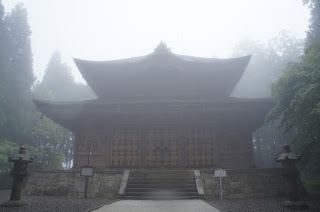It's been a long time since I've written something on this blog.
I haven't been to KIN29 SHOP for a long time either, because judging from the lineup on Facebook, there was an impression that new tees were yet to be marketed.
And besides, I had second thoughts about the idea of going to crowded Ikebukuro these days.
So, instead of typing about Kinnikuman tees or AOT novelties, today I would like to write about a more spiritual aspect of Japan.
BTW, I personally consider Buddhism as philosophy rather than religion.
Also, my position is rather new-age-ish and pop compared to hard-core devotees.
However, if this article sounds too religious or uncomfortable, please close the browser.
I know from experience that each person's comfort zone is different (particularly regarding religious and political issues), and I don't want to be counted as one of these fellows who force their beliefs/values on others.
So much for disclaimer.
Now, let me post some images from Hieizan (Mt. Hiei), a sacred mountain near Kyoto where Enryakuji (a group of temples registered as World Cultural Heritage) is located. We went on a short trip there about half a month ago.
By the way, most people use Hieizan and Enryakuji as a synonym.
Enryakuji is located between Shiga prefecture and Kyoto.
It started as a humble hut in 785 AD, where Dengyo Daishi-Saicho trained in quest for truth.
Daishi represents rank, meaning high priest; Saicho is the first name Dengyo Daishi earned when he entered into priesthood. Sai stands for "the most" and Cho stands for "pure" in Chinese character.
His denomination--Tendai-shu--gained the trust of Emperor Kanmu, and was recognized as a religion to protect the nation.
His belief was, in a phrase, "Shed light on a small corner of this world".
He called those who shed light were the true national treasures; those who possess sincerity and are respected by people are the ones that outshines even a mass of biggest jewels.
It is said that his wish was to cultivate such people in Hieizan.
Enryakuji is also expressed as the motherly mountain because even after Dengyo Daishi's death, many monumental figures in Japanese Buddhism (who are mentioned in standard Japanese history classes) were educated in this mountain.
We decided to visit the temple concurrently with the opening time, since we knew it would be crowded by noon.
Just before 8:30AM, the treely Hieizan was filled with fog and misty rain, which added a measure of grace and spirituality befitting the ancient temple.
At that time, except for a group of elderly couples, we were the only visitors waiting for the gate to open.
Enryakuji is divided into three stupa areas, and we began with To-do (East Stupa) since this is where the booking office and the centerpiece of the mountain, the Konpon-chudo, are located.
The gate opened, and the second we stepped into Dengyo Daishi's world, the voices of the priests (and pilgrims, maybe?) chanting a sutra flowed via a loud speaker nearby.
This was a personally stunning moment...I felt as if I had been transported through time to ancient Heian Period.
In principle, it is prohibited to take pictures inside the building, so I just took them from outside.
The icon of Yakushi Nyorai (Bhaisajyaguru; a form of Buddha that delivers happiness in this world. On the other hand, Dainichi Nyorai/Vairocana delivers benefits in afterworld. Specifically, taking the deceased to the land of happiness ), the faint colors on botanical arts on high ceiling, the aroma of homa filling the hall of Konpon-chudo...their holiness are all beyond description.
Even if your schedule won't allow you to see all three regions, I highly recommend visiting To-do area.
By the time we left Kokuho-den (national treasure storage building) in To-do area, around 10:30AM, the rain stopped. When I left the building, my retinas were surprised by the sudden bright sunlight.
This museum-like facility is also interesting, especially for those who are art-lovers. Tons of statues--the oldest are from 9th Century--are simply marvelous.
Next, we drove to Sai-to (West stupa) area. The area is rich with old temples. In contrast with To-do area, it has a tranquil taste. In my impression, To-do had a rather leonine air.
Jodo-in is Dengyo Daishi's mausoleum. The priest dwelling in this temple serves Daishi as if he is alive. When I visited here, I could hear a resonant voice chanting sutra from this ancient building.
Including Jodo-in, many of these temples are off-limits, so beware. I recommend just to pass by if the gates to the hall are closed.
When we arrived at Yokawa--the third and last area--we ran into many sightseeing buses and private cars. We felt we were right in visiting at early morning.
Honestly, I was kind of tired walking...or rather...hiking by the time I came to Yokawa.
Yokawa was established by Jikaku Daishi almost right after Dengyo Daishi's death.
The most popular temple would be Ganzan Daishi-do (Ganzan Daishi's stupa, also known as Shiki-kodo), where Ganzan Daishi took up his residence.
This high priest is known for his legend of transforming into an ogre to protect the commoners. A quite lovely picture of Ganzan Daishi as an ogre is featured in monuments and souvenirs.
A fun experience of bell tolling@belfry near Yokawa-chudo. Ah, let me note that I was wearing Buffaloman's white shirt with white jeans and black parka.
For details of Mt. Hiei/Enryakuji, visit the official description in English. I borrowed some expressions from this passage.
http://www.hieizan.or.jp/_att/english.pdf

































コメント
コメントを投稿